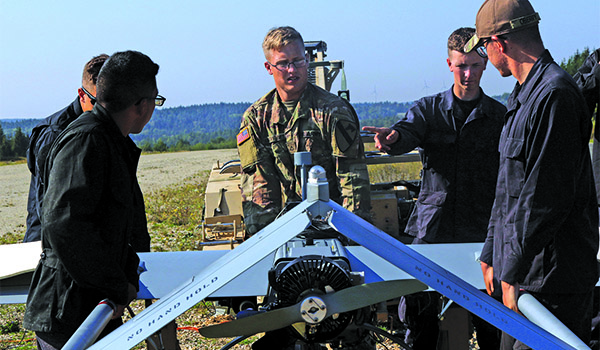
Aviation Branch Chief Update / By MG William K. Gayler: Clarity is the counterbalance of profound thoughts. —Luc De Clapiers

Soldiers with the 91st Engineer Battalion mount an AAI RQ-7 Shadow Unmanned Aerial Vehicle on a UAV launch assembly during the Saber Junction 18 exercise in Hohenfels training area, Germany, Sept. 20.
Don’t let accuracy get in the way of clarity; in other words, as we weave the minute details into a plan, an explanation, or a requirement, we often become so enthralled with the process that we drift away from the original intent and completely lose sight of the big picture – the singular reason for what we are doing. It seems that the more technical the topic, the more prone we are to slipping down this rabbit hole. Take for instance unmanned aircraft systems (UAS).
As an integrated component of Army Aviation, our UAS capabilities are constantly evolving in order to maintain operational parity with our current and future manned fleet as we strive to provide our combatant commanders the capabilities they need. Like our manned aircraft we can expect our UAS to operate in an ever-expanding diverse set of conditions, against near-peer adversaries in contested airspace conducting multi-domain operations. An accurate picture, but to add some clarity to an already cluttered battlefield, what do we expect of our UAS? They must be able to provide the complementary capabilities required of our manned aircraft – to find things, kill things and move things – and do so at an affordable point and be survivable on the battlefield.
Updating the UAS Road Map
As we modernize our aviation capabilities to meet, and overmatch, the threats we see on the battlefield today and the ones we expect to face tomorrow, we have found our 2009 UAS Road Map to be a bit outdated. However, it does give us a good appreciation of where we were ten years ago and how far we have come. During this time we have updated doctrine to reflect lessons learned on the battlefield, we have fundamentally restructured our heavy attack cavalry squadrons (HARS) with the integration of organic UAS, we have placed UAS officers and noncommissioned officers in the appropriate locations across the Army’s force structure (from Corps to Divisions down to brigade combat teams (BCTs)) to educate /influence/employ UAS assets in the manner most appropriate to the mission. We are in the process of updating our UAS Road Map, but you can be assured of one thing, the focus of the document will lend clarity on how to make Army Aviation better by integrating and improving our UAS capabilities.
We will, fairly quickly, figure out what capabilities we need to pursue as our Gray Eagle fleet evolves to become more effective at finding and killing the enemy and surviving to do it again, somewhat mirroring the success we have had with our Apaches. As we revolutionize the capabilities in the HARS, replacing the Shadow with the Advanced UAS (AUAS) we will optimize our teaming capabilities. Likewise, the capabilities brought onboard by the replacement of the Raven in the BCTs with the Future UAS (FUAS), will significantly increase the lethality and reach of our current air ground operations (AGO), significantly enhancing the effectiveness of our combined arms team. Having said that, it is important to remember that the “things,” these air vehicles, are only one component of the capability that is needed to achieve the desired effectiveness. Real modernization has to encompass the Soldiers who employ these systems.
The Center of Gravity
Often lost in translation, is that while our unmanned aircraft systems don’t have anyone onboard during the mission, there are still entire organizations of Soldiers that plan, launch, fight, recover and repair every single “unmanned” platform. Another fact that gets lost in translation is that while UAS formations have different personnel structures and are not fought or trained quite like manned aviation, they do require an equivalent level of skill, leadership and subject matter knowledge as that required by their manned counterparts.
UAS is a growth industry, in both the military and civilian career fields. The demand for Soldiers is astounding and one of the most important parts of our work on the upcoming UAS Road Map is to address the human aspect of our capability.
We can really break this into a couple of specific areas. Do we have the right organizational structure for our Soldiers? It may suffice for counter insurgency operations, but is it capable of meeting the demands of large scale combat operations (LSCO)? If we do have to reorganize our structure to meet the demands of LSCO, do we have the right mix of people – enlisted/officer and are they the appropriate rank? What about field service representatives (FSRs)? Are we training our people right? Maybe, but are we taking advantage of modernizing our training as we modernize our platforms? Does the Synthetic Training Environment provide us with a better, more holistic and faster set of tools to train our new UAS Soldiers? Do these same set of tools work to improve home station training as well?
Make no mistake, the Soldiers – the manned portion of our unmanned aircraft systems – are our center of gravity, and it is critical that we chart the best path forward for them that we can in both our current and future formations. Updating our UAS Road Map is the next step in this ongoing process for the singular reason of ensuring we have the right capabilities to meet the Army’s needs across all domains.
Above the Best!
MG William K. Gayler is the Army Aviation branch chief and commander of the U.S. Army Aviation Center of Excellence and Fort Rucker, AL.








